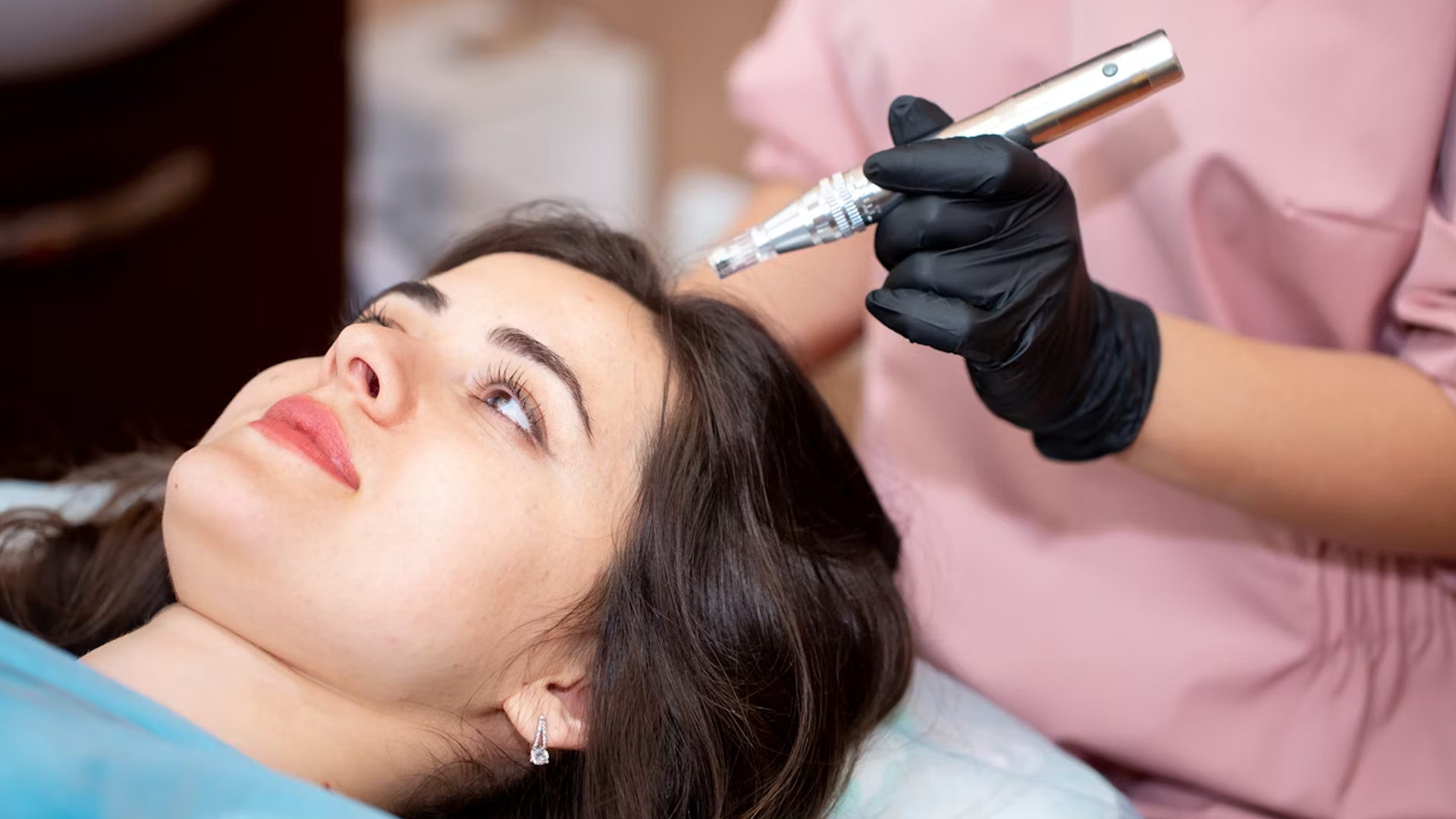Index
- What is scalp microneedling?
- How does scalp microneedling work for hair growth?
- Biological mechanism
- Benefits of scalp microneedling on the scalp
- Main benefits of scalp microneedling
- Who are ideal candidates for treatment?
- Step-by-step process of a scalp microneedling session
- Initial evaluation
- Scalp preparation
- Scalp microneedling application
- Application of hair actives
- Completion and aftercare
- Aftercare and recommendations
- Immediate post-treatment care
- Recommendations to enhance results
- How many sessions are needed and when will results be seen?
- Recommended protocol
- Expected results
- Conclusion
- Frequently asked questions
What is scalp microneedling?
Scalp microneedling is an innovative technique in the world of advanced aesthetics. This procedure consists in the use of a special device equipped with ultra-fine microneedles that lightly pierce the surface of the scalp. The objective of these controlled micro-injuries is to stimulate collagen production and tissue regeneration, essential factors for strengthening and activating hair follicles.
Each microperforation triggers a natural healing response in the skin, generating a cascade of growth factors that promote blood circulation and revitalize the hair follicle. This results in stronger, thicker and healthier hair, visibly diminishing the signs of thinning hair.
If you are interested in exploring other techniques that integrate technology and wellness, I recommend you learn more about what advanced aesthetics is and how it can benefit your wellness.
How does scalp microneedling work for hair growth?
The magic of scalp microneedling lies in its ability to harness the body’s natural repair mechanisms. When the microneedles penetrate the scalp, microscopic channels are created that serve several key functions:
- They stimulate blood flow to the follicles, providing oxygen and essential nutrients.
- They activate the production of collagen and elastin, two proteins essential for the regeneration of hair tissue.
- Promote the release of growth factors that accelerate cell regeneration.
- They increase the absorption of topical products such as serums or minoxidil solutions, enhancing their effectiveness.
Unlike other treatments, this technique does not require surgical intervention, deep anesthesia or long recovery periods, making it ideal for those seeking visible results in a safe and natural way.
Biological mechanism
- Controlled injury: The microneedles create small wounds in the scalp.
- Stem cell activation: Stem cells in the hair follicles are stimulated.
- Release of growth factors: Regeneration and strengthening of the hair is promoted.
- Increased vascularization: Improves the supply of nutrients to the hair follicle.
Benefits of scalp microneedling on the scalp
Applying scalp microneedling professionally offers a number of short and long term benefits. Unlike invasive treatments or medications that can cause side effects, this technique harnesses the body’s natural processes to progressively and safely improve hair health.
Main benefits of scalp microneedling
- Promotes new hair growth: By activating dormant follicles, it is possible to increase hair density.
- Strengthens existing hair: Improves the thickness and strength of weakened hair strands.
- Improves blood circulation in the scalp: Better vascularization optimizes follicle nutrition.
- Increases the effectiveness of other treatments: By opening microchannels in the skin, it facilitates the penetration of capillary actives.
- Minimizes inflammation and oxidative damage: Factors that often contribute to hair loss.
In addition, many patients report a significant improvement in scalp texture, reducing dryness, irritation and sensitivity, which promotes an optimal environment for healthy hair growth.
In the context of holistic care, this technique can be complemented with skin rejuvenation strategies beyond aesthetics: comprehensive care, achieving total wellness.
Who are ideal candidates for treatment?
Not all types of hair loss respond equally to scalp microneedling, so it is important to identify who can benefit most from this procedure.
Ideal candidates include:
- Individuals with generalized hair thinning.
- Individuals with early to moderate stage androgenetic alopecia.
- Those who have experienced postpartum or stress-related hair loss.
- Individuals seeking to enhance other topical treatments or hair medications.
- Individuals interested in improving the quality and texture of their scalp.
However, it is not recommended for people with active scalp infections, severe inflammatory conditions such as psoriasis, or those undergoing chemotherapy treatments.
A prior evaluation with a hair health specialist is essential to ensure that the patient is suitable for the treatment and to obtain the best results.
Step by step process of a scalp microneedling session
Knowing the procedure helps to reduce anxiety and better understand how the results are achieved on the scalp. Below, we share with you the usual process in a scalp microneedling session:
1. Initial evaluation
The specialist performs a diagnosis of the patient’s hair condition, assessing factors such as hair thickness, follicular density and scalp conditions.
2. Scalp preparation
The area is cleaned and disinfected to eliminate residues, grease and contaminating agents. In some cases, a topical anesthetic cream is applied to reduce the sensation of discomfort.
3. Application of microneedling
With the help of a specialized device -which can be a dermaroller or a dermapen- a controlled sweep is made over the entire surface of the scalp, generating uniformly distributed microchannels.
4. Application of capillary actives
Immediately after micropuncture, solutions enriched with growth factors, peptides or vitamins are applied, optimizing their absorption thanks to the microchannels created.
5. Completion and aftercare
Detailed information is provided on the care to be followed by the patient to maximize the results and minimize the risk of irritation or infection.
Aftercare and recommendations
After a scalp microneedling session, it is essential to follow a series of care procedures to optimize the results and avoid any complications. Although it is a minimally invasive procedure, the scalp needs a short recovery period.
Immediate care after treatment
- Avoid washing the hair during the first 24 hours: The scalp needs time to heal the micro-injuries.
- Do not apply irritating products: Products with alcohol, strong fragrances or chemical treatments should be avoided.
- Avoid direct sun exposure: It is crucial to protect the scalp from the sun for at least 48 hours.
- Do not scratch or rub the scalp: This can interfere with the healing process.
Recommendations to enhance results
- Use mild shampoos free of sulfates and parabens.
- Apply hair serums recommended by the specialist, preferably rich in peptides or growth factors.
- Maintain a balanced diet rich in iron, zinc and B vitamins, all essential nutrients for hair health.
- Perform periodic sessions according to the defined protocol (usually every 4 weeks for a period of 3 to 6 months).
This care helps the treatment to have a more lasting and visible impact, especially when performed as part of a comprehensive approach to hair health.
How many sessions are needed and when do I see results?
Scalp microneedling is not an instant solution, but a progressive treatment that requires consistency to achieve optimal results. The number of sessions and the time needed to see improvement may vary depending on the patient’s initial condition and goals.
Recommended protocol
- Initial treatment: One session every 3 to 4 weeks.
- Total duration: 3 to 6 sessions on average.
- Maintenance: 1 session every 2 to 3 months after the main treatment.
Expected results
- 1 month: Slight improvement in scalp texture.
- 2-3 months: Decrease in hair loss and appearance of new hair.
- 4-6 months: Visible increase in hair density and thickness.
It should be noted that the response to treatment varies according to factors such as age, general health, hormone levels and type of hair loss. Discipline in following the protocol and post-treatment care are key to ensure success.
Conclusion
Scalp microneedling has revolutionized the treatment of hair loss thanks to its natural, effective and minimally invasive approach. Through mechanical stimulation of the scalp, this procedure boosts cell regeneration, strengthens hair follicles and promotes the growth of stronger, denser hair. In addition, its ability to enhance the absorption of topical treatments makes it a strategic choice for those seeking to maximize their hair recovery efforts. By following a proper protocol, combining it with aftercare and healthy habits, patients can achieve remarkable and sustainable results over time.
Scalp microneedling is an ideal alternative for those who wish to combat hair loss without resorting to invasive methods or expensive surgery. However, prior evaluation by a specialist is key to determine the best personalized strategy.
Frequently asked questions
- Is scalp microneedling treatment painful? The scalp microneedling procedure may cause slight discomfort, as it involves the creation of microperforations in the scalp. However, to minimize any discomfort, specialists usually apply a topical anesthetic cream before beginning the session. Because of this, most patients describe the sensation as mild tingling or small pinpricks, rather than actual pain. The level of discomfort can also vary depending on the individual patient’s sensitivity and the type of device used (dermapen or dermaroller). In general, the procedure is well tolerated and does not require prolonged recovery times.
- How long does a hair microneedling session take? A typical hair microneedling session lasts between 45 minutes to an hour. This time includes:
- The preparation of the scalp (cleaning and application of anesthesia).
- The performance of the microneedling procedure itself.
- The subsequent application of serums or hair growth factors to take advantage of the microchannels opened in the skin.
Each session is designed to be as efficient as possible, allowing the patient to resume daily activities with minimal interruption.
- Can I wash my hair after treatment? It is highly recommended to wait at least 24 hours before washing your hair after undergoing a scalp microneedling session. This is crucial to:
- Allow the skin’s natural healing process to proceed without interference.
- Reduce the risk of infection or irritation.
- Maintain the benefits of the hair actives applied immediately after the session.
When washing the hair after this period, a mild shampoo should be used, preferably without sulfates or parabens, to avoid damaging the scalp, which is still in the process of recovery.
- When will I start to see results? Hair regeneration is a biological process that takes time. Generally, patients begin to notice:
- First visible changes in texture and reduction of hair loss after 2 to 3 months of treatment.
- Significant growth and increase in hair density after 4 to 6 months, after completing several periodic sessions.
It is important to emphasize that results depend on individual factors such as age, general health, the cause of hair loss and adherence to the treatment plan and aftercare.
Scalp microneedling is considered a medium to long term treatment, but the benefits are usually long lasting if a proper maintenance protocol is maintained.
- Can microneedling completely stop hair loss? Scalp microneedling is a powerful tool to combat hair loss, but it does not represent a definitive cure, especially in cases of advanced genetic alopecia. Its main function is:
- To significantly reduce hair loss.
- Stimulate new hair growth in areas where follicles are still active.
- Strengthen existing hair, improving its thickness and resistance.
For best results, microneedling should be part of a comprehensive hair treatment approach, which may include lifestyle changes, proper nutrition, stress management and the complementary use of topical or systemic treatments as determined by a specialist.


